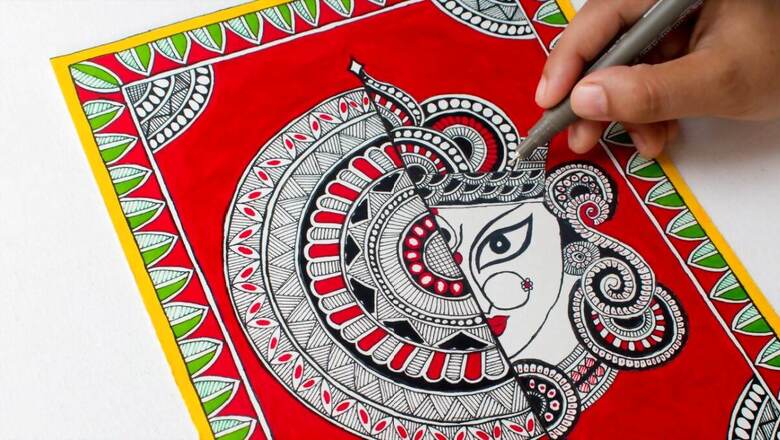
views
Diwali being a festival of lights, there is vibrancy and exuberance all around and this is reflected in the décor at homes.
Most Indian folk art has traditionally been used either for decorative or religious purposes and hence is artistic, vibrant and colourful. Additionally, all of them are made using natural pigments- mineral, stone or vegetable which add to the beauty of each artwork. Art is very personal and has to highlight and simultaneously blend with the décor of your home, so what better than knowing about different folk art forms and choosing the one that appeals to you the most. After all, every piece of art or painting has a story and vibe and it must match with the ideologies or aesthetics of the person choosing it for his/her home. Pragati Agarwal, Founder and Managing Director, Art Tree shares 4 aesthetically appealing folk art forms that one can explore in depth this Diwali before acquiring it.
Madhubani/Mithila
Madhubani Painting, also known as Mithila Art, is a style of Indian painting practised in the Mithila region of Bihar and the adjoining parts of Terai in Nepal. Traditionally these paintings were created by women on walls and floors of homes during festivals, ceremonies or special occasions. It is said to date back to the time of Ramayan when King Janak asked an artist to capture his daughter Sita’s wedding to Prince Ram. Even though this art is centuries old in the native place of Mithila, the practitioners take pride in preserving its original style and content.
Today, Madhubani paintings are made using fingers and twigs, as well as matchsticks and pen nibs. Generally, bright colours derived from natural dyes are used in these paintings with an outline made from rice paste as its framework leaving barely any blank spaces. If there’s a border, it is embellished with geometric and floral patterns. The paintings are characterised by figures that have prominently outlined, bulging fish-like eyes and pointed noses.
Pattachitra
Believed to be more than 1000 years old, Pattachitra is one of the oldest and most popular art forms of Odisha, and has evolved from the Sanskrit words ‘patta’ (canvas) and ‘chitra’ (picture). The nomenclature meaning ‘cloth-picture/painting’ in Sanskrit, is a generalised term used to describe a style and format of painting with origins in Odisha and West Bengal.
These paintings are said to have originated as early as the 12th century. Its unique feature is the natural colours with a gauze-like fine cotton cloth coated with white stone powder and gum made out of tamarind seeds that make the canvas ready to accept the paint.
Originally, Pattachitra was created for ritual use and as a souvenir for pilgrims to Puri, and other temples in the state. The artists known as ‘Chitrakars’, predominantly made icon paintings based on Hindu mythology. As times progressed, the art evolved into a more varied form through Lord Jagannath who is a ‘swaroop’ of Lord Krishna and has been the major source of inspiration to this day.
Phad
A 700-year-old legacy passed down over generations within a single family, Phad finds its origins in Shahpura, near Bhilwara, Rajasthan. Phad is a type of scroll painting that narrates elaborate religious stories of local deities and gods. Created as travelling or mobile temples, these traditional paintings were carried by priest-singers of the Rabari tribe, called Bhopas and Bhopis, who would sing and perform stories of their local deities – Devnarayanji (a reincarnation of Vishnu) and Pabuji (a local hero). The Phad painting would be unrolled or unfolded after sunset, and the performance before village members would last into the night. This is perhaps why the paintings are called ‘Phad’, which means ‘fold’ in the local dialect.
Traditionally, Phad is made on cloth – 30 feet long and 5 feet wide in vibrant colours. The most important detail in the paintings is added last – the eyes. Once the main deity’s eyes are painted, the artwork comes alive and is ready for worship. The artist signs the artwork close to the image of the main deity, which is typically placed in the centre of the painting.
Sanjhi
Sanjhi- The delicate art of papercutting is said to have originated from the times of Lord Krishna and has evolved over time from the sanctum of the temples. A rare art from Braj, the word ‘Sanjhi’ means evening or dusk and is more of an expression of the devotional love that was unveiled in the temples. It is said to have originated at the time of Lord Krishna when Radha and Gopis to used to create beautiful patterns out of leaves and flowers creating decorations for Krishna to impress the lord. Subsequently, the art grew in the 16th and 17th centuries when the walls and floors of temples were decorated with Sanjhi.
Sanjhi is said to be prolific during the period of ‘Pitrupaksha’ (The Bhadrapad month of the Hindu calendar) generally for a fortnight, in the memory of one’s ancestors and as devotion towards the Lord. In present times, there are only three temples in Mathura where one can see the traditionally made Sanjhi. Among them are the Radha Raman Mandir, the Radha Vallabh Mandir, and the Bhattaji Mandir.

















Comments
0 comment